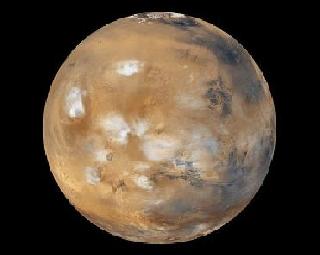
Mars. A NASA photo.
WASHINGTON (AP): NASA has said it is not giving up on Mars, but it will have to get there later and at a lower price.
President Barack Obama's announced this month budget cancelled joint US-European robotic missions to Mars in 2016 and 2018. Now top science officials say they are scrambling to come up with a plan by the end of the summer for a cut-rate journey to the red planet in 2018.
NASA sciences chief John Grunsfeld said he thinks there is a better than even chance that NASA will not miss the 2018 opportunity. That is when Mars passes closest to Earth, which happens only once every 15 years. It offers a chance at fuel cost-savings and the ability to send up more equipment.
Agency officials who met with upset scientists Sunday seemed intent on salvaging a programme that took some of the deepest science spending hits in the president's budget. Until this month, NASA had been ramping up its Martian ambitions.
Meanwhile, in the middle of this year, the most high-tech rover ever, Curiosity, will land near the Martian equator in search of the chemical building blocks of life. The more scientists study Mars, the closer they get to answering whether microbial life once existed there, a clue to the ultimate question: Are we alone?
Two years ago, President Barack Obama stood at Kennedy Space Center and said it was more of a priority than going to the moon. He wanted astronauts there by the mid-2030s.
But the two coming missions were then cancelled along with the most ambitious Mars flight yet planned, which the National Academy of Sciences endorsed as the No. 1 solar system priority. That was a plan to grab Martian rocks and soil and bring them back to Earth. Now that is "not an option" given the current budget, Grunsfeld said.
Mars researcher Steve Squyres of Cornell University, who headed the national academy panel, said if NASA could not make progress on a Mars sample return, the space agency should think about moving on to the next priorities, such as visiting Jupiter's moon Europa.
"We're really at a crossroads," NASA planetary sciences chief Jim Green said.
NASA said it does not quite know what a reconfigured 2018 mission would look like, but it would be cost-capped at USD 700 million and it will not be landing. If it is lucky, it may orbit Mars.
After Curiosity lands in August, the next NASA Mars surface mission probably is close to a decade away, Grunsfeld said.
To scientists, the message from the White House seems simple: Bye-bye, Mars.
If Obama's budget sails through as outlined, "in essence, it is the end of the Mars programme," said Phil Christensen, a Mars researcher at Arizona State University. It is like "we've just flown Apollo 10 and now we're going to cancel the Apollo programme when we're one step from landing," he said.
 Previous Article
Previous Article Next Article
Next Article













The Indian Air Force, in its flight trials evaluation report submitted before the Defence Ministry l..
view articleAn insight into the Medium Multi-Role Combat Aircraft competition...
view articleSky enthusiasts can now spot the International Space Station (ISS) commanded by Indian-American astr..
view article